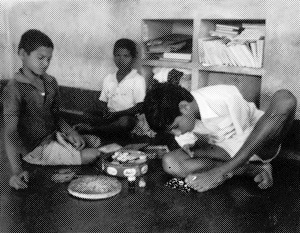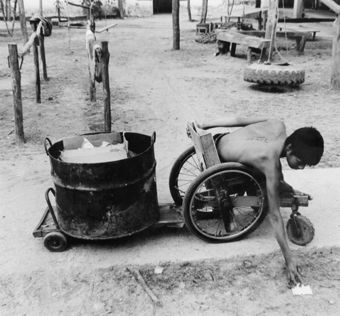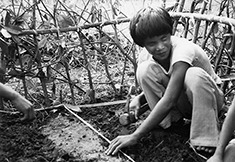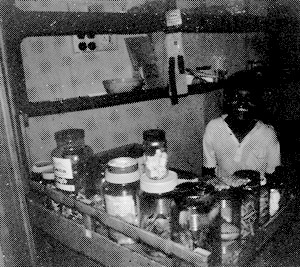Hesperian Health Guides
Learning Skills for an Active Role in the Community
HealthWiki > Disabled Village Children > Chapter 54: Work: Possibilities and Training > Learning Skills for an Active Role in the Community
 |
| In Melkote, India, the Janapada Seva Trust teaches village children with disabilities many productive skills. Here, a boy without hands uses his foot to draw greeting cards, which are later sold. |
Contents
- 1 Development of the mind
- 2 Adaptations for farm work and gardening
- 3 Alternatives to farm work
- 4 Making craft goods out of old junk—an experiment in Pakistan
- 5 Marketplace crafts for self-employed production by people with disabilities
- 6 WIRE BIRD OR SMALL ANIMAL CAGE
- 7 TIN SPOONS
- 8 COCONUT SHELL SERVING SPOON
- 9 BROOM
- 10 PAPER BAGS
- 11 CANDLES
- 12 FLY SWATTER
Development of the mind
Learning skills that require more mental than physical activity can help children with physical disabilities to gain a place in the community.
For development of skills such as reading, writing, and arithmetic, when possible, it is usually best that children with disabilities go to school. Ideas for helping a child get to school and be accepted there are discussed in Chapters 47 and 53. If a child cannot go to school, figure out ways for her to be taught at home—perhaps by schoolchildren.

As soon as the child learns to read and write, try to buy or borrow simple, interesting, and educational books. With these the child can develop her mind further.
Starting a village library is often an excellent idea. In fact, a young person with disabilities may be able to become the village librarian—and a non-formal educator.
To open up other possibilities, help your village recognize both the needs and value of people with disabilities and other disadvantaged persons (such as single mothers). When deciding who to choose for public service jobs and community responsibilities, try to make it a village policy to consider choosing persons who have disabilities.
Although they may be unable to do hard physical farm work, people with disabilities can often make outstanding health workers, cooperative administrators, shop keepers, librarians, “cultural promoters,” or child care center coordinators—if they are given the chance.
Adaptations for farm work and gardening
Persons with weakness in their lower bodies and who have strong arms and hands can learn a wide variety of work skills where they can sit and use their hands. (See list of skills.) However, for many villagers, the growing of food is central to their lives.
If certain adaptations are made, villagers with disabilities can often help with farming and gardening. Here are a few suggestions.
Aids for Crawling |
Elevated Gardens |
 knee pads—from pieces of old rubber tire padded inside
hand walker
|
 family garden elevated for work from wheelchair (Notice the elevated garden outside the the “model home” in the photo on "Adapting the Home and Community".) |
OFF-ROAD TRANSPORTGetting to distant fields over rough trails may be difficult for the young person who cannot walk. A simple carrying frame can be used to carry the child and also the tools and grain. |
 |
GUIDELINES OR RAILSFor the child with vision loss, or who has difficulty with balance, hand rails may make it easier to get from the house to the garden, the latrine, and the well or water hole. |
 |
Alternatives to farm work
Many villagers with disabilities will need to learn skills other than farm work. If unemployment is high it may not be wise to train people with disabilities for jobs where there is a lot of competition. In fact, any sort of paid job may be hard to get. Therefore, it often makes more sense to teach young people with disabilities skills so that they can become self-employed. Or perhaps several people with and without disabilities can become partners in a small home industry.
A village-based rehabilitation center with a shop can teach young people with disabilities different manual skills such as leatherwork, clothes making, woodworking or welding. While they are with the program, they can use these skills to make a wide range of rehabilitation and orthopedic equipment. They can also make toys, chairs, leather goods, clothes, and other objects for sale. The income from the sale of these things can help cover some of the costs of the rehabilitation program and training. When the learners have gained enough skills, perhaps the community program can help them set up their own small shop in their home, village, or neighborhood.
In several countries, organizations that serve people with disabilities have started revolving loan plans that provide a craftsperson with the basic equipment to start their own small business. The loans are paid back little by little over a reasonable time, so that the same money can be used to help another person with disabilities get started.

In the West Indies, the Caribbean Council for the Blind provides a guarantee to local banks which give start-up loans to people with disabilities. So far, 97 percent of the people with disabilities who have received loans have met their payments on time. This is the bank’s best repayment rate! It helps convince bankers not only that people with disabilities can run their own small businesses responsibly, but that they are a good investment. By involving local banks in the loan program, the public is being educated toward a new respect and appreciation for people with disabilities.
Villagers with disabilities can become skilled in a wide variety of manual skills. Here we list some skills that are taught in different rehabilitation programs, training programs, and workshops.
The above list includes only a few of the activities that people with disabilities have learned in order to run their own small business or set up shop in their home. As much as is possible, let a person with disabilities decide what skill or skills she wants to learn. Choices that are possible will depend on the person’s combination of abilities, and interest as well as on the local situation, resources, market, training opportunities, and other local factors.
Making craft goods out of old junk—an experiment in Pakistan
Leaders in the Community Rehabilitation Development Project in Peshawar, Pakistan realize that in their country it is very difficult for people with disabilities to earn a living. Most either live by begging, are cared for by their families, or die of neglect. Since chances of employment are so limited, it is more realistic to help people with disabilities learn simple craft skills for self-employment at home (if they have a home) or in the marketplace. They can make small things at low cost and sell them in the marketplace. If their small business helps the family a little or covers part of their daily expenses, something has been gained.
In the marketplace of Peshawar there is a variety of clever, simply made cages, tools, utensils, toys and other objects, mostly made out of very low-cost or waste materials. The Project has hired a self-taught craftsperson to collect, study, and make design plans for some of these marketplace things, so that people with disabilities can learn to make and sell them. To follow are a few examples. For more complete instructions, write to Mental Health Centre, Mission Hospital, Peshawar, N.W.F.P., Pakistan.
Marketplace crafts for self-employed production by people with disabilities
These examples and the examples on the next page are from FAMN/UNICEF Community Rehabilitation Development Project, Peshawar, Pakistan.
WIRE BIRD OR SMALL ANIMAL CAGE

TIN SPOONS

COCONUT SHELL SERVING SPOON



BROOM

PAPER BAGS

CANDLES

OF WAX
tube
FLY SWATTER






